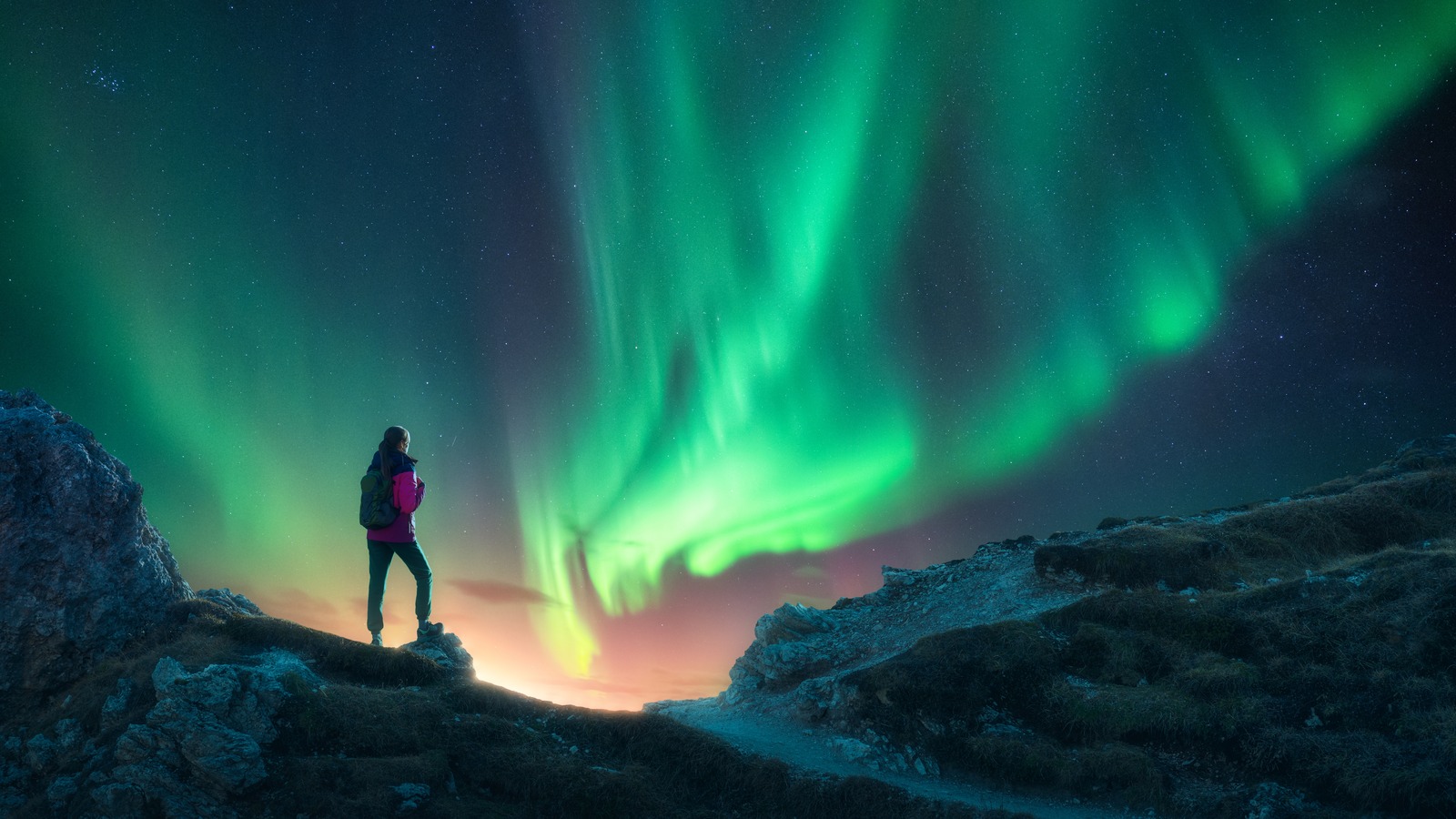
What’s Behind The Cause Of Northern Lights? Aurora Borealis Explained – SlashGear
Aurora borealis, or northern lights, is one of nature’s most spectacular and, at the same time, complex phenomena. The mesmerizing light show we see here on our planet results from particles that originate roughly 93 million miles away from the Sun. The particles travel across space and collide with Earth’s atmosphere, leading to wavy light patterns in the polar night sky.
To understand what aurora borealis is, you must have a basic idea of what solar wind is, how long it takes to reach Earth, how it interacts with our planet’s magnetic field, and a tad about how atoms and molecules emit light when they’re ionized or excited. But don’t worry, as we’ll walk you through all the seemingly arduous concepts one by one.
First, you should know where the scientific name, i.e., aurora borealis, comes from. Although the earliest references to the northern lights have been found in 30,000 years old cave paintings, it was in 1619 that the Italian astronomer Galileo Galilei coined the term aurora borealis. The first word, “Aurora,” is after the Roman goddess of dawn, and the second word, “Boreas,” refers to the Greek god of the north wind.
Now that you know what aurora borealis means, let’s dive into what causes the phenomenon.
What is solar wind?
 NASA Space Place/YouTube
NASA Space Place/YouTube
Let’s start with what solar wind is. The closest star to planet Earth, our Sun, is a burning ball of gasses that radiates a lot of heat in every direction. Along with the heat, Sun also emits charged particles (electrons, protons, or ions) into our solar system, called the solar wind, at speeds that could range between 250 to 500 miles per second. Depending upon their velocity, these energetic particles reach the Earth in a couple of days.
On their way to Earth, solar winds are slowed down by the Earth’s magnetosphere, which consists of magnetic field lines. At the equator, these lines are nearly parallel to Earth’s surface and don’t allow the particles to penetrate the atmosphere. However, they redirect the charged particles toward the poles (due to Lorentz Force).
For those catching up, the magnetosphere is the three-dimensional space around our planet where its magnetic field is dominant. Further, the atmosphere is the layer of gases surrounding the Earth, denser around the equator and weaker around the poles.
While the atmosphere stretches to over 6,000 miles from the surface of Earth, the magnetosphere extends to about 40,000 miles toward the Sun (and over 370,000 miles in the direction away from the Sun), which is why the charged particles encounter the magnetosphere first.
How charged particles interact with Earth’s magnetic field
 EarthSky
EarthSky
So far, we’ve learned about how the solar winds travel from the Sun to our planet, where they interact with the planet’s magnetic field. Now, we’ll understand how the collision of solar winds with the gases in our atmosphere emits light.
As they move along the converging magnetic field lines and reach the poles, the charged particles enter the atmosphere. Here, they collide with nitrogen and oxygen and transfer their energy to the gases’ molecules. This excites the electrons in the molecules, pushing them to a higher energy level. If the particles have excessive energy, they can also remove electrons from molecules, causing ionization. In both states, the molecules are unstable.
As excited electrons return to the stable state (or ionized molecules re-combine with free electrons), they emit additional energy in the form of visible radiation. Since this process occurs closer to the polar surface — in the thermosphere, which begins at about 50 miles from sea level — we can see the emission of excessive energy as light. This is what we call northern light or aurora borealis in the Northern Hemisphere. In the Southern Hemisphere, it is called aurora australis, where “australis” means “southern.”
Since the emission of solar wind from the Sun is an ongoing process, our planet has auroras 24 hours a day. However, they aren’t visible in daylight.
It’s not easy to track the northern lights
 NOAA/Shikhar Mehrotra/SlashGear
NOAA/Shikhar Mehrotra/SlashGear
Generally, auroras appear greenish-yellow in color, mainly due to the excitation of oxygen molecules in the atmosphere. Further, red wavy patterns in the polar night sky happen due to the excitation of nitrogen molecules.
Auroras are a random phenomenon, and it’s tough to predict when they will occur. However, the chances of viewing the northern lights are the highest in the winter, from September to March, when the sky is darker and the nights are longer. The aurora borealis is easily visible in the northern regions of Iceland, Sweden, Finland, Norway, Canada, and Alaska (areas in latitudes between 60 to 75 degrees). Hence, you’ve got plenty of options to view the magical sight of northern lights, especially if you’re planning a vacation.
If there’s strong solar activity, people at lower latitudes can also see auroras, like in northern England. Monitoring solar activity becomes crucial in predicting northern lights and the likeliness of encountering one. The Space Weather Prediction Center shows a 30-minute forecast of where the auroras could show up. In addition, you should also check the local weather forecast, as cloudy or overcast conditions often hide the northern lights. A place without light pollution provides the best overall view of the northern lights.































![iFi's GO Bar Kensei Dongle DAC Supports K2HD Technology With Some Samurai Swagger [Updated] iFi's GO Bar Kensei Dongle DAC Supports K2HD Technology With Some Samurai Swagger [Updated]](https://i0.wp.com/cdn.ecoustics.com/db0/wblob/17BA35E873D594/33FF/45A11/QTXOLJR4xDKSNMMk2WlTgjaIlvSgcYpeU1xJzUwIoYs/ifi-go-bar-kensei.jpg?w=768&ssl=1)

























